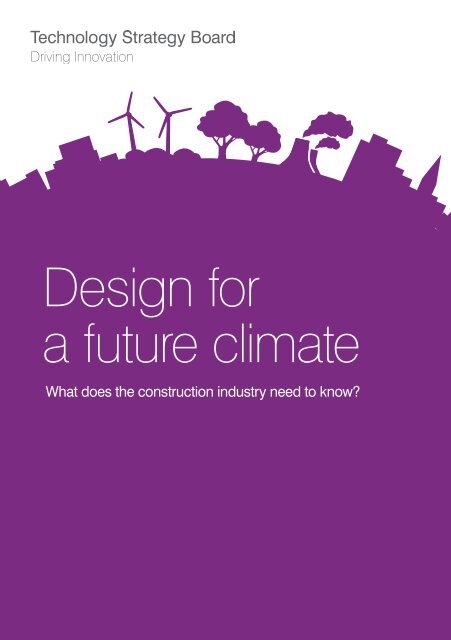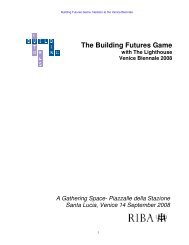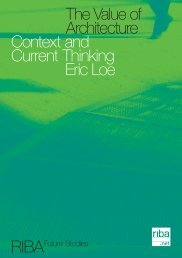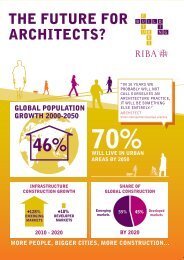Design for a future climate - Technology Strategy Board
Design for a future climate - Technology Strategy Board
Design for a future climate - Technology Strategy Board
Create successful ePaper yourself
Turn your PDF publications into a flip-book with our unique Google optimized e-Paper software.
<strong>Design</strong> <strong>for</strong><br />
a <strong>future</strong> <strong>climate</strong><br />
What does the construction industry need to know?
The Earth’s <strong>climate</strong> is changing –<br />
wetter winters and drier summers will<br />
affect existing buildings and change<br />
the requirements of new buildings.<br />
The increasing release of greenhouse<br />
gases like carbon dioxide is causing<br />
<strong>climate</strong> change. To try to halt the rate<br />
of change the government aims to cut<br />
carbon dioxide emissions by 80% by<br />
2050 – but nearly half the UK’s carbon<br />
emissions come from buildings.<br />
Buildings last a long time, so we<br />
need to design buildings that<br />
dramatically cut their energy<br />
consumption and carbon emissions<br />
to slow down <strong>climate</strong> change, that<br />
can adapt to the changes that are<br />
already inevitable, and which people<br />
enjoy living and working in.<br />
<strong>Design</strong>ers and builders<br />
need to understand the<br />
likely impacts of <strong>climate</strong><br />
change to create robust<br />
and <strong>future</strong> proof buildings.<br />
In spring 2010 we are launching an<br />
R&D competition ‘<strong>Design</strong> <strong>for</strong> Future<br />
Climate’ to help develop innovative<br />
ideas to make our buildings<br />
fit <strong>for</strong> the <strong>future</strong>.<br />
01 <strong>Technology</strong> <strong>Strategy</strong> <strong>Board</strong>
What have we done so far?<br />
• In December 2008 we brought together<br />
<strong>climate</strong> scientists and construction<br />
experts to debate what was known about<br />
<strong>climate</strong> change, and how it related to the<br />
built environment.<br />
• Although the <strong>climate</strong> scientists have a<br />
huge amount of knowledge about the<br />
possible impacts of <strong>climate</strong> change, it is<br />
not available in a way that is useful to the<br />
construction industry.<br />
• Since then a group of industry experts<br />
has been working with us, the Natural<br />
Environment Research Council and the<br />
UK Climate Impact Programme - to turn<br />
the scientific knowledge into practical,<br />
usable advice.<br />
associations to make the advice and<br />
guidance on <strong>climate</strong> change impacts as<br />
clear and usable as possible.<br />
• In early 2010 we will make this advice<br />
and guidance available as part of the<br />
preparation <strong>for</strong> our ‘<strong>Design</strong> <strong>for</strong> Future<br />
Climate’ competition.<br />
• We’ll work with the knowledge transfer<br />
networks, professional bodies and<br />
trade associations to spread the advice<br />
and guidance as widely as possible<br />
through industry.<br />
What happens next?<br />
• We’ll get feedback on this work at our<br />
workshop at the Innovate ‘09 conference.<br />
• We will work with the Modern Built<br />
Environment Knowledge Transfer<br />
Network, professional bodies and trade<br />
<strong>Technology</strong> <strong>Strategy</strong> <strong>Board</strong> 02
Not only will existing buildings need to<br />
withstand the predicted wetter winters<br />
and drier summers, but by the 2080s<br />
or sooner, buildings of the <strong>future</strong> will<br />
need to respond to possible greater<br />
extremes of wind, rain and temperature.<br />
We must all take action now<br />
We’re working with the Natural Environment<br />
Research Council and the Engineering<br />
and Physical Sciences Research Council<br />
(ESPRC) to pinpoint the in<strong>for</strong>mation that the<br />
construction industry needs and make sure<br />
it’s available to architects and builders in a<br />
user-friendly <strong>for</strong>mat.<br />
<strong>climate</strong> change prediction data into more<br />
usable <strong>for</strong>ms <strong>for</strong> industries working with<br />
existing buildings and infrastructure<br />
including transport and water resource<br />
systems. The project work is available by<br />
joining the Adaptation and Resilience in a<br />
Changing Climate network, open to all at<br />
www.ukcip-arcc.org.uk<br />
The ESPRC-funded Living with<br />
Environmental Change programme<br />
accredited a range of research projects on<br />
Adaptation and Resilience in a Changing<br />
Climate in 2007-08. These projects<br />
allow academics to convert<br />
03 <strong>Technology</strong> <strong>Strategy</strong> <strong>Board</strong>
The <strong>Technology</strong> <strong>Strategy</strong> <strong>Board</strong><br />
competition will further support this ef<strong>for</strong>t<br />
by funding industry R&D <strong>for</strong> adaptation to<br />
the <strong>future</strong> <strong>climate</strong>.<br />
By the 2080s<br />
The latest predictions from UK Climate<br />
Projections 2009 point to a very different<br />
weather pattern <strong>for</strong> the UK in the <strong>future</strong>.<br />
We could be faced with:<br />
• a wetter winter and a drier summer in<br />
every part of the UK<br />
• a 22% decrease in average summer<br />
rainfall in the South East – which is<br />
already water-stressed<br />
We are working with the construction<br />
industry to:<br />
• appreciate that <strong>climate</strong> change is also<br />
going to change the way the industry<br />
works and makes money<br />
• an increase of 16% in average winter<br />
rainfall in the North West, with increases<br />
in the amount of rain on the wettest<br />
days leading to a higher risk of flooding<br />
• a rise in sea levels by up to 36cm.<br />
• begin working together to change<br />
construction practice, products<br />
and processes<br />
• provide the right in<strong>for</strong>mation to the<br />
construction industry so that the<br />
built environment can cope with<br />
<strong>climate</strong> change.<br />
<strong>Technology</strong> <strong>Strategy</strong> <strong>Board</strong> 04
The big questions<br />
‘Data and modelling on<br />
temperature, rainfall and solar<br />
radiation have to be closely<br />
linked together and not<br />
treated in isolation in order to<br />
be useful <strong>for</strong> design.’<br />
‘We need practical<br />
in<strong>for</strong>mation about<br />
the implications of<br />
<strong>climate</strong> change on<br />
the built environment,<br />
not what caused it.’<br />
Understandably there are many questions<br />
on <strong>climate</strong> change being posed by the<br />
construction industry. And so far there’s no<br />
easy route to the answers. We recognise<br />
the urgency of assisting the construction<br />
industry and have taken action to begin<br />
a process of transferring and translating<br />
in<strong>for</strong>mation between the academic<br />
sector and the industry.<br />
‘There’s too much<br />
in<strong>for</strong>mation about <strong>climate</strong><br />
change but where can we<br />
find the relevant data and<br />
how do we use it? I need<br />
low cost, trustworthy,<br />
factual in<strong>for</strong>mation.’<br />
‘What about building codes<br />
and building regulations?<br />
Surely <strong>climate</strong> change<br />
in<strong>for</strong>mation has to be<br />
integrated into these.’<br />
05 <strong>Technology</strong> <strong>Strategy</strong> <strong>Board</strong>
‘National data on <strong>climate</strong><br />
change is all very well but<br />
we need to understand<br />
local, and even micro<strong>climate</strong>,<br />
variations to be<br />
able to design, specify<br />
and construct buildings<br />
<strong>for</strong> the <strong>future</strong>.’<br />
‘I’ve heard the new <strong>climate</strong><br />
predictions are based<br />
on 10%, 50% and 90%<br />
probabilities. We still aren’t<br />
fully using the single figure<br />
predictions from 2002. We<br />
need help in using the<br />
data. What <strong>climate</strong> change<br />
consequences can be<br />
predicted with confidence?’<br />
In<strong>for</strong>mation needed by the<br />
construction industry<br />
• local micro<strong>climate</strong> in<strong>for</strong>mation<br />
including temperature, rainfall, solar<br />
radiation and wind<br />
• how the predicted availability of<br />
resources, such as gas/electricity<br />
energy sources, are influenced<br />
by <strong>climate</strong> change<br />
• urban wind and urban flooding<br />
predictions, to indicate both the<br />
likelihood and potential impact<br />
• clarification on extreme events. Can<br />
the probability of extreme weather<br />
events be broken down regionally?<br />
What will extremes of <strong>climate</strong> be<br />
like in 30 years’ time? And will more<br />
regular extreme weather events such<br />
as storms, flooding, heat waves<br />
and droughts affect structural and<br />
material stability?<br />
• site-specific <strong>climate</strong> change<br />
in<strong>for</strong>mation <strong>for</strong> designers<br />
• how <strong>climate</strong> change will affect the<br />
population; how will they react? Will<br />
the public tolerate the change or will<br />
their actions make predictions worse?<br />
• engineers need help interpreting<br />
the practical implications of <strong>climate</strong><br />
change margins of error.<br />
<strong>Technology</strong> <strong>Strategy</strong> <strong>Board</strong> 06
Who are we working with?<br />
The following organisations have helped<br />
us so far: Aecom, Arup, Atkins, British<br />
Geological Survey, Buro Happold,<br />
Chartered Institution of Building Services<br />
Engineers, Construction Industry<br />
Council, Kier, Modern Built Environment<br />
Knowledge Transfer Network, Land<br />
Securities, Liverpool John Moores<br />
University, Newcastle University,<br />
Southampton University, Taylor Woodrow<br />
and the Zero Carbon Hub.<br />
We would like to hear from you<br />
To get involved in this work and <strong>for</strong> further<br />
in<strong>for</strong>mation about the <strong>Design</strong> <strong>for</strong> Future<br />
Climate competition, please contact:<br />
Fionnnuala Costello<br />
FionnualaCostello@tsb.gov.uk<br />
Who we are<br />
The <strong>Technology</strong> <strong>Strategy</strong> <strong>Board</strong> is the<br />
UK’s innovation agency set up in 2007.<br />
www.innovateuk.org<br />
The Natural Environment Research<br />
Council funds world-class science in<br />
universities and its own research centres.<br />
www.nerc.ac.uk<br />
The Engineering and Physical<br />
Sciences Research Council is the<br />
UK’s main agency <strong>for</strong> funding research in<br />
engineering and the physical sciences.<br />
www.epsrc.ac.uk<br />
The UK Climate Impacts Programme<br />
helps organisations to adapt to inevitable<br />
<strong>climate</strong> change.<br />
www.ukcip.org.uk<br />
and Richard Miller<br />
Richard.Miller@tsb.govuk<br />
© <strong>Technology</strong> <strong>Strategy</strong> <strong>Board</strong> October 2009 T09/083<br />
<strong>Technology</strong> <strong>Strategy</strong> <strong>Board</strong><br />
North Star House<br />
North Star Avenue<br />
Swindon SN2 1UE<br />
T 01793 442700<br />
E enquiries@tsb.gov.uk<br />
www.innovateuk.org<br />
This brochure has been printed by the BAPC (British Association<br />
<strong>for</strong> Print and Communication) ‘Environmental Printer of the<br />
Year’ 2008 using waterless printing, a lithographic process that<br />
eliminates water consumption and the release of VOCs (volatile<br />
organic compounds) into the atmosphere. Printed on an FSC<br />
certified paper made with 100% post consumer waste and<br />
bleached using a Totally Chlorine Free process.






